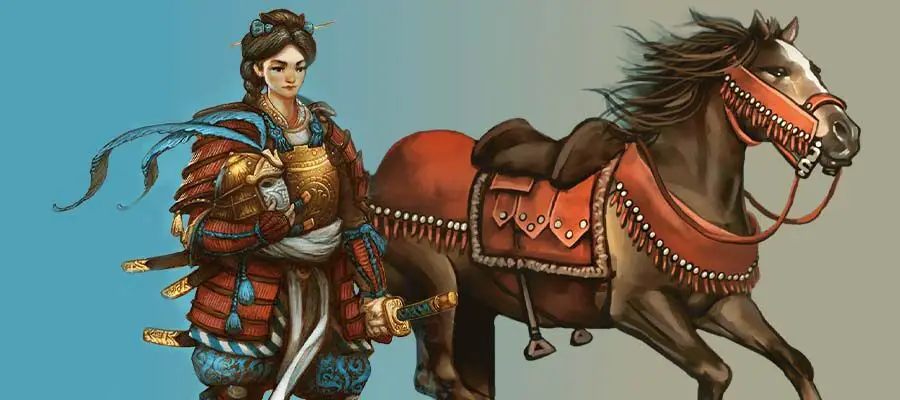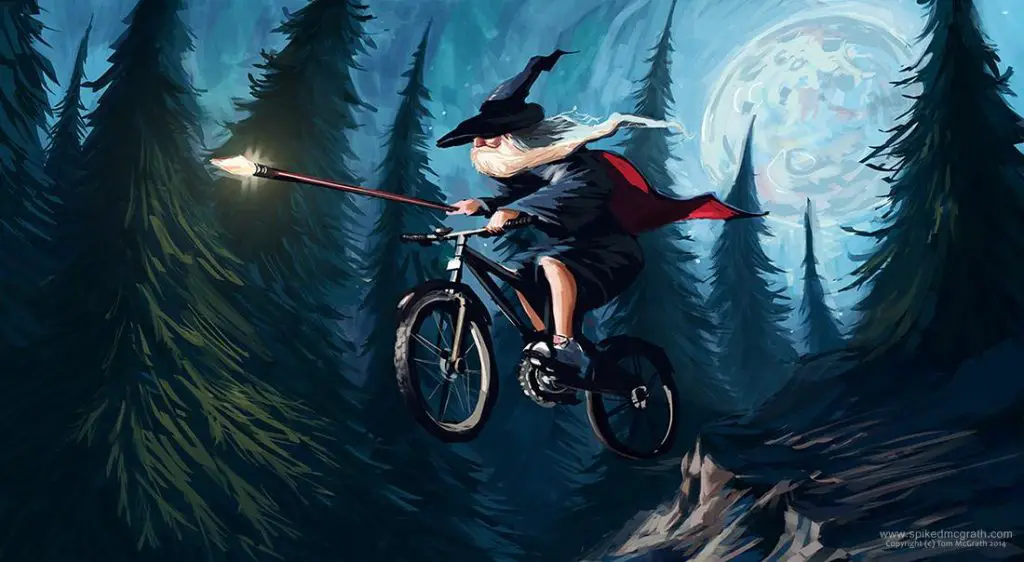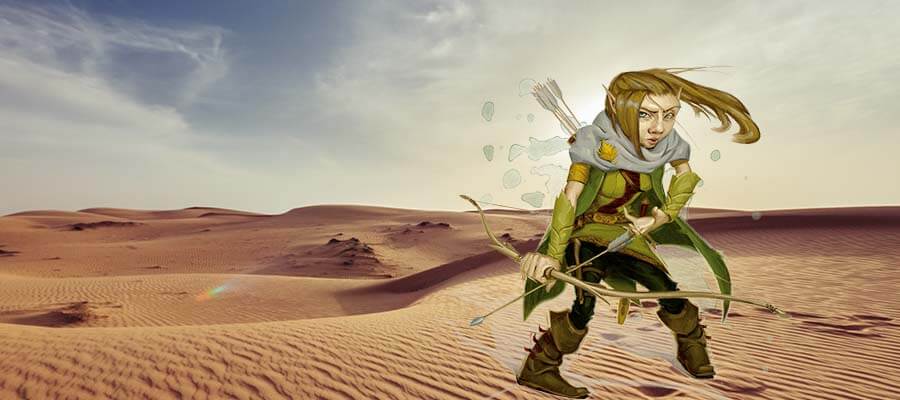Druid mount combo featured image is a combination of images credited to Wizards of the Coast.
Disclaimer: This article contains affiliate links that add gold to our coffers.
A Paladin rides into combat atop a Giant Elk, armed with a lance and shield. She tears through the hordes of goblins as her elk stomps her enemies beneath his hooves. The goblins attempt to strike at the elk, but all their blows are deflected by the Paladin. A goblin Booyahg Booyahg Booyahg desperately throws a Fireball in a last-ditch effort to stop the advancing pair. Through the flames and smoke, the Paladin and elk charge forward unscathed and run the goblin spellcaster through. The pair have cleared a path for their party to follow as they lead the charge through the goblin army.
Combining the utility of mounted combat with the Druid’s ability to Wild Shape, this build will require a martial class and a Druid: two willing player characters cooperating for a fantastic combination.
The build takes advantage of the Mounted Combatant feat and the Druid’s ability to act as an independent mount. See our article on mount rules for a refresher on how mounts work, especially the “Mounted Combat” section. This combo gives both the martial class and the Druid a boost beyond what they could get separately, creating perfect synergy.
Beyond just the mechanical advantages, it can also give rise to some roleplaying opportunities between the two characters. Are they old friends who have found a way to combine their talents to form a terrifying force? Are they a sibling duo with a gimmick? What level of trust does it take to ride an intelligent mount, and how does that play into their respective characters?
The Character Builds
I’ll describe how I visualize each character behaving in combat and other scenarios. Multiclass ideas will be included since many players enjoy multiclassing. Let’s start with the Druid before the martial rider.
Pure Druid Mount
The main appeal of going pure Druid comes from the 18th and 20th level abilities, so these really only come into play if your adventure will be taking you to those levels. The 18th-level ability Beast Spells allows you to cast spells while in your beast form with the condition that they don’t require a material component. In addition to being able to cast concentration spells like Call Lightning and Tsunami, you can cast single-action spells like Heal or Blight. The Druid’s capstone ability Archdruid gives you unlimited Wild Shape uses and allows you to ignore material components that aren’t consumed and don’t require a gold cost, greatly increasing your versatility with Wild Shape.
First, a player will pick the Circle of the Moon Druid subclass. There are a lot of potential paths this build can take, so let’s first focus on the advantages the Druid gets from this build before moving on to some options to add extra synergy. The Mounted Combatant feat, which a martial rider will need to take, allows them to redirect attacks against the mount to the rider. This greatly increases their survivability in Wild Shape form, especially for lower CR options. Additionally, the feat essentially gives the mount Evasion, which gives them an edge on some of the most common Area of Effect spells.
A great way to take advantage of this increased survivability is to cast a concentration spell as an action before transforming into a beast as a bonus action. Spike Growth could give a tactical advantage on the map. Flaming Sphere can let the Druid use their bonus action in Wild Shape form to do additional damage.
An important limitation to keep in mind for the Druid’s Wild Shape ability is that you cannot cast spells while transformed. You also do not gain the benefits of any of your special senses from your race or class (such as darkvision or blindsight) while in your beast form, unless the beast form already has that sense. You cannot transform into a creature with a swimming speed until level 4, and you cannot transform into a creature with a flying speed until level 8.
Beyond this starting choice, there are several different paths the Druid can take depending on how they want to synergize with their martial companion.
Multiclassing
The Druid’s Wild Shape has great multiclassing potential with most classes due to a vital part of Wild Shape: you can use any class feature as long as your new form is physically capable of doing so. Combined with the perks of beast forms often having higher damage output and getting multiattack at low CRs, this can make your beast form a terrifying mount.
Additionally, in regards to multiclassing into a class that gives Extra Attack, that ability will allow beasts who do not have the Multiattack ability to make two attacks. It will also allow you to choose which two attacks you make, while a beast’s Multiattack ability will instead specify which attacks to take (e.g. one Bite attack and one Claw attack).
Barbarian
Multiclassing into a Barbarian, often referred to as a Bearbarian, will give you access to Rage, which adds additional damage to your melee weapon attacks, as long as you use strength. It also gives you resistance to bludgeoning, slashing, and piercing. Another benefit you get access to is the Unarmored Defense ability, which sets your AC to 10 + your Constitution modifier + your Dexterity modifier. It’s important to note that, while Wild Shaped, your Constitution and Dexterity are determined by your animal form. This means that the Unarmored Defense sometimes provides no boost, often provides a boost of +1 or +2, and rarely can boost your AC by +3.
The Paths you can take as a Barbarian offer many choices. If you want to bring chaos into your build, the Path of Wild Magic gives you a random boost when you start raging that ranges from teleporting to damage to boosting your AC. The Path of the Storm Herald could turn you into an electric mount, allowing you to use your Bonus Action to shoot bolts of lightning. If you prefer to bolster your allies, the Path of the Ancestral Guardian allows you to single out an enemy to suffer disadvantage on attack rolls against anyone but you. If they hit another creature, that creature will have resistance to the damage. Paired with the Mounted Combatant feat of your rider, this could greatly increase the build’s durability.
Multiclassing into a Barbarian is a great way to increase your survivability in your Beast Shape form, though remember that you cannot concentrate on any spells while raging.
Monk
Similar to the Barbarian, you gain access to the Monk’s Unarmored Defense, but this time your AC becomes 10 + your Wisdom modifier + your Dexterity modifier. While your Dexterity will be determined by your beast form, your Wisdom is not, and since both Monks and Druids use Wisdom for their class features, this could provide a huge boost to your animal form AC. Additionally, you gain use of Ki, which can make for some terrifying combos in your beast form, such as making upwards of 4 attacks on your turn. The Monk’s Unarmored Movement also further increases your speed as a mount. If you put 5 levels into Monk, you gain the Stunning Strike ability, a truly terrifying ability to put in the hands of a Polar Bear or a Triceratops.
If you want to see what a Druid/Monk multiclass can do outside this build, check out our article on playing a Ninja Monkey.
Paladin
The main draw of multiclassing into a Paladin as a Druid is to be able to use your Druid spell slots for smiting in your beast form. This will make sure your Druid spell slots don’t sit around unused while transformed, which, as the mount for this build, will likely be often. Additionally, you get the Lay on Hands ability for some extra healing. If you don’t want your Fighting Style ability to go to waste, you could ask your DM to use the optional class feature Blessed Warrior in TCoE on p.52, which gives you two Cleric cantrips.
The Martial Class Build
The only hard requirement for the martial class part of the build is that they need the Mounted Combatant feat. This feat will allow you to redirect attacks from your mount to you instead, which may be vital in protecting your mount if they can’t take the damage. Additionally, you will gain advantage on your melee weapon attacks against any creature who is smaller than your mount. The Druid can Wild Shape into beasts that are Huge in size starting at level 6, so that means you’ll be getting advantage against most creatures you’ll be fighting. Beyond the Mounted Combatant feat, there are several classes that have great synergy with the build, depending on what aspect you want to emphasize.
Fighter, Cavalier Martial Archetype
Any Fighter subclass can work with this build, but the Cavalier has some extra synergy. The Born to the Saddle ability allows you to mount your Druid steed by expending only 5 ft of movement instead of half your movement speed. It also gives advantage on staying in the saddle and, if you fall out of the saddle, reduces some of the negative effects of that. If paired with the reach of a lance or glaive, the Hold the Line ability can stop enemies before they can even attack you or your mount.
Paladin, Oath of the Ancients
Paladins with high AC can benefit particularly from this build’s synergy as it extends the survivability of their Druid friend. The advantage from the Mounted Combatant feat can make Paladins extra scary as it increases their chances to crit and double their smite damage. Beyond just the general Paladin abilities, the aura effects from the different Oaths can bring huge boosts. The Oath of the Watchers gives a bonus to initiative rolls, the Oath of Glory increases the speed of your mount, and the Oath of the Ancients’ Aura of Warding gives your mount resistance to damage from spells, further increasing your mount’s survivability from spells that use saving throws. Additionally, the flavor of the Oath of the Ancients can pair well with the flavor of the Druid.
Barbarian, Path of the Totem Warrior
Going with the Bear Totem Spirit can dramatically increase your survivability as you absorb all the attacks that would have gone to your mount. Alternatively, choosing the Wolf Totem Spirit will give your mount advantage on their attacks. The advantage on attacks that the Barbarian gets from the Mounted Combatant feat also synergizes with their Brutal Critical ability, since crits have a higher chance of happening.
Wizard, Bladesinging Arcane Tradition
This one is a little bit out there, as a Wizard normally can’t take many hits. However, the Bladesong Wizard can reach a ridiculously high AC that can protect them when they redirect the attacks against their mount. Additionally, if the mount needs to retreat, the Bladesong Wizard has the option to dip into their ranged spells and wreak havoc on the battlefield.
Rogue
A match made in Celestia, the main attraction to Rogues in this build is their automatic advantage on attacks from the Mounted Combatant feat allowing them to use their Sneak Attack against any foe. Refer to our Rogues on Horseback article for a breakdown on how this subclass can shine in mounted combat.
The Saddle of a Druid Mount
A vital part of the build is in the saddle. While a saddle is not needed for mounts such as a Warhorse, an exotic saddle is required for riding any flying or aquatic mount, as per pg.155 of the Player’s Handbook. Since Druids can choose which equipment merges into their Wild Shape and what equipment is worn by the new form, the Druid can wear the saddle at all times to be ready for battle. Wearing a heavy saddle as a humanoid would be awkward (the exotic saddle weighs 40 lbs!), so check with your DM first to see if they’ll allow it. Additionally, it may be worthwhile to seek out the magic item Saddle of the Cavalier. Beyond the mechanical benefits, as long as the DM allows it, the saddle can magically change to fit the form, as described on pg.140 of the Dungeon Master’s Guide.
Benefits and Drawbacks vs a Traditional Mount
One of the main benefits of using this two-player combination over a traditional mount is the versatility the duo has in various environments. While a traditional mount may have to be left behind when entering buildings or caves, a Druid can wild shape in and out of form when necessary, as long as there’s space to fit them. Additionally, with the ability to transform into beasts with swimming or flying speeds at higher levels, this creates a toolbox of mounts that can be used to match the situation.
Further building on versatility, a Druid mount doesn’t produce the same logistical challenges as a regular mount. While a regular mount requires additional feed and separate lodging when in town, a Druid transforms back into the party and shares in their needs. Druids can even serve as mounts for long-distance traveling if the party is willing to take a few short rests throughout the day to replenish the Wild Shape uses.
However, one of the major drawbacks is that the Druid, as a player character, acts independently on their own turn. This can create tactical problems on the battlefield when positioning matters. For example, if the rider needs to retreat or move to attack other enemies, they have to wait for the Druid to move on the Druid’s turn.
To overcome this challenge, ask your Dungeon Master how you can gain an ability that allows the two of you to share initiative. Perhaps as you two work together over time, your bond as a unit develops, and you find yourselves in sync on the battlefield. This could come in the form of a magic item, a feat, a boon, or a magical effect.
Conclusion about a Druid Mount
If you’re able to find a buddy to partner up with you, this combination creates an intimidating presence and a force to be reckoned with. Be sure to check with your DM beforehand as the rules on mounts and the Wild Shape ability can leave some gray areas where your DM might have a different interpretation. Mounted combat is often underutilized in D&D, so take advantage of this unique synergy between classes and show your friends the power of mounts!




